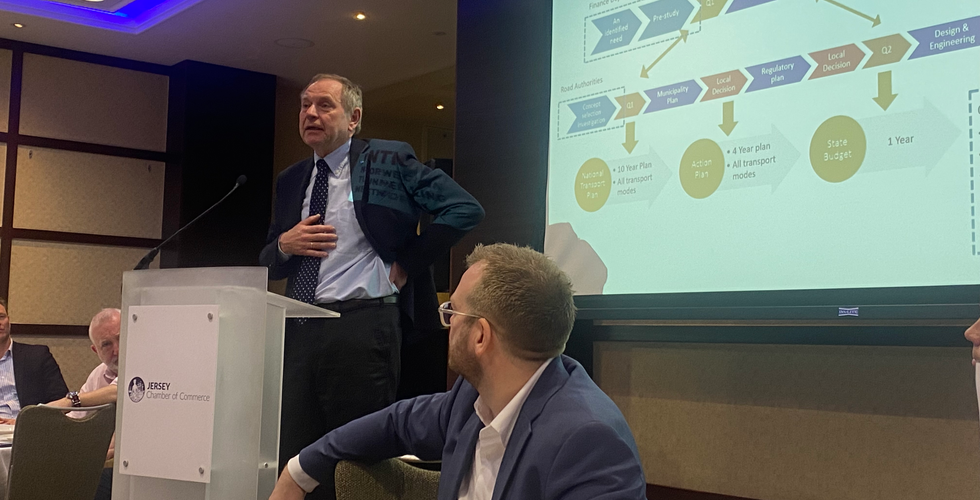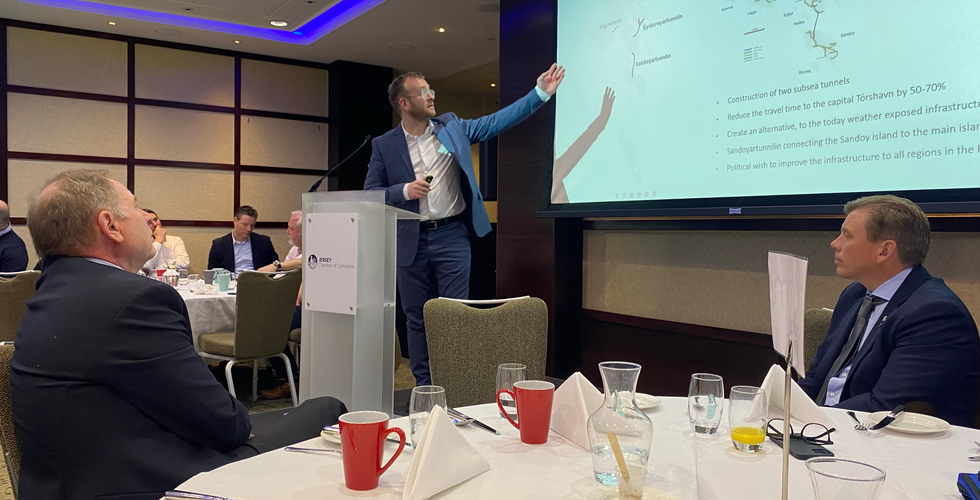Fixed links between the Channel Islands and mainland France
- Arild Petter Søvik

- 8. mars 2024
- 3 min lesing
Oppdatert: 10. mars 2024
In March 2024, Norwegian Tunnelling Network, represented by Network Director Arild Petter Sovik and Professor Eivind Grov from SINTEF, together with Teitur Samuelson, CEO of Eystur- og Sandoyartunlar (Faeroe island), presented insights from sub-sea tunnelling in Norway and the Faeroe Islands in a contribution to the discussions on new fixed links between Guernsey and Jersey and Jersey and mainland France.

The fixed links will most likely be two sub-sea rock tunnels, each approximately 30 km long, which provide an inter-island connection and connect to mainland France. This solution has good potential for a positive impact on economic growth, environment, and future development for the Channel Islands and the local region of Normandy. In addition, the sub-sea link will connect to vital infrastructure functions, like passenger hubs and cargo terminals, in both islands and mainland France.
«A fixed link between Guernsey and Jersey is more than just an infrastructure project. It is a social, economic and environmental project with the potential to transform the lives and prospects of citizens, businesses and society..»
The Connect 3 Million initiative
Connect 3 Million is an initiative launched in 2019 by a consortium of local businesses in support of investigating the fixed link between Guernsey, Jersey, and France.
From the Norwegian Tunnelling Network’s point of view, the overall conditions that will influence the technical part of planning and constructing the fixed links are similar to what has been experienced in Norway. Available but limited information at hand today on the geological conditions provided so far and seen on the island outcrops indicates that the ground conditions are quite similar to those faced in sub-sea projects in Norway in particular, but also in the Faeroe Islands. However, as experienced in Norway and the Faeroe Islands, fault zones and areas of geological concern need to be investigated, particularly in the areas between the islands and the mainland.
Teitur Samuelson, CEO of Eystur- og Sandoyartunlar, presented how the sub-sea projects were financed in the Faroe Islands and the significance of such investments for local communities and the Faroe Islands.
The nature of a sub-sea tunnel project and the risks involved require experience with similar projects and requirements, guidelines, and suit processes that are the actual conditions. The tools at hand are contractual risk-sharing principles, conventional risk analysis, and a risk register dedicated specifically to sub-sea tunnel projects. It is specially made to ensure project delivery on time and on budget, with a quality that provides cost-effective operation and maintenance.
«Public engagement with globally credible speakers proved to be a critical turning point in the discussions over fixed links between the Channel Islands and France. Arild Petter Søvik, Teitur Samuelsen, and Eivind Grøv brought significant credibility to the Chambers of Commerce discussions. Stephen Whitham from Ramboll also contributed to their discussions in Jersey. Many business leaders arrived open-minded to the idea of a fixed link and came away with high levels of confidence that a fixed link tunnel was not just achievable, but desirable. This change in tone was widely reported in the media across both islands.»
Martyn Dorey, Dorey Financial Modelling
The Channel Islands are well known for their granite, and the Blue Guernsey Granite is found in use on the steps of St Paul’s Cathedral in London. This means the rock itself is a good quality material and excavation might provide material that would be an asset for the islands. The material is already used within the communities for construction, sea, and landfilling purposes, and it can contribute significantly to a financial profit for the project.
Necessary investigations and surveys must be carried out to determine the best tunnel route and relevant methods for the excavation. Studies will indicate the potential financial surplus gained from utilizing the excavated rock masses locally. The Norwegian tunnelling method, with drill and blast tunnelling, will make such a profit possible and also provide a cost-effective method to excavate a tunnel in the actual ground conditions between Guernsey and Jersey and Jersey and France. A TBM-bored tunnel is also likely a feasible solution. Pre-excavation grouting and probing will be essential for a successful tunnelling operation.
On Tuesday, March 5th, and Wednesday, March 6th, the team held presentations and discussed the issues with government deputies and officials, stakeholders, the government, and the public. Here is a chance to have a look at the presentations on Guernsey (YouTube video).
The Norwegian Tunnelling Network is grateful for the opportunity to present and discuss sub-sea tunnels with government officials, deputies, stakeholders, and the public of Jersey and Guernsey. We are open to sharing our experiences, starting a collaboration, and contributing to a sound investment process for the Channel Islands.

















Kommentarer